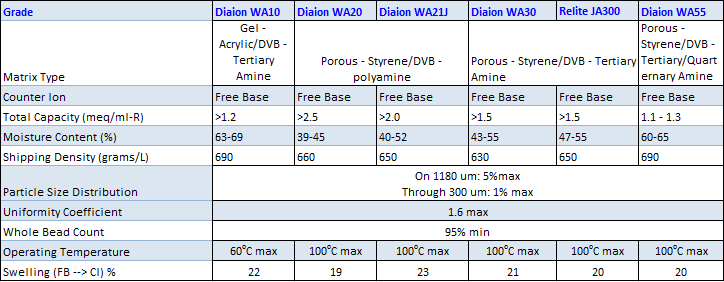Weakly Basic Anion Exchange Resins
WA10 resin is based on gel-type acrylic polymer matrix. It has tertiary amine functionality with high regeneration efficiency. The acrylic polymer matrix provides good chemical stability and good resistance to organic fouling. WA10 is mainly used for pretreatment of starch hydrolysates, beet sugar solutions, and formaldehyde.
WA20 and WA21J do not have any neutral salt splitting capacity. They have high total exchange capacity and high regeneration efficiency. The porous styrene polymer imports high chemical stability, high mechanical strength against attrition loss, high thermal stability, and high durability against organic fouling. These resins are used for the removal of strong mineral acids in standard water treatment applications. They can also be applied in special process separations such as the treatment of organic solvents.
WA30 resin is a weak base anion exchange resin based on porous, styrene-DVB polymer matrix with dimethyl amine functionality. The high porous styrenic matrix has excellent chemical stability, mechanical and osmotic strength, high thermal stability, and durability against organic fouling. WA30 is the bench mark which all macroporous weak base exchange resin are compared with. It is used for a variety of applications, such as removal of organic substances of high molecular weight, pretreatment of raw waters containing organic foulants, deionization and decolorization of starch hydrolysates, and purification of glycerine and enzymes.
WA55 is a unique weak anion resin to Mitsubishi Chemical where the total capacity is equally divided between strong base functionality (quaternary amine) and weak base functionality (tertiary amine). This resin is used in the production of demineralized whey enriched with proteins. With whey containing approximately 50 g/l lactose, proteins, beta-carotene, amino acids, organic acids and mineral salts, the anions and organic acids are removed by WA55 with a minimum loss of protein and reversible adsorbtion of beta-carotene.

